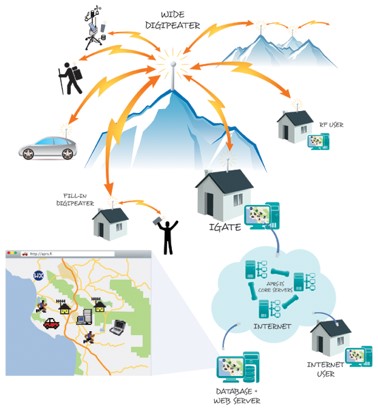Understanding APRS Paths: A Detailed Guide
The Automatic Packet Reporting System (APRS) is a digital communication protocol used by amateur radio operators to share real-time information about their locations and other data. Central to the operation of APRS is the concept of paths, which control how packets are distributed and retransmitted across the network. This detailed guide explores the intricacies of APRS paths, starting from basic packet transmission to advanced digipeating techniques and network management.
Basic APRS Packet Transmission
An APRS packet consists of several key components: the source callsign, the destination callsign, and the data payload. The structure of a basic APRS packet without any specified path looks like this:
N0CALL>APRS:!1234.56ND01037.50E&
In this example:
N0CALLis the source callsign.APRSis the destination callsign.- The
>character separates the source from the destination. - The
:character separates the header from the actual data. - The data payload,
!1234.56ND01037.50E, represents position information in APRS format.
A packet like this does not involve any digipeaters or specified paths. As a result, it will be transmitted directly without any additional processing or retransmission by intermediate stations. However, it can still be picked up by iGates (Internet Gateways) and forwarded to the APRS-IS (Internet System).
Introduction to Digipeating
Digipeating is a method used to extend the range of APRS packets by using intermediate stations known as digipeaters. These digipeaters receive a packet and then retransmit it to other digipeaters or end stations. Digipeaters follow the AX.25 protocol rules and are configured to handle packet paths.
Classic AX.25 Digipeating
In the classic AX.25 protocol, the digipeater path is included after the destination callsign. For example:
N0CALL>APRS,OH7RDA,OH7RDB:!1234.56ND01037.50E&
Here, OH7RDA and OH7RDB are specified as the digipeaters. When a packet is sent with this path, it will be digipeated by OH7RDA first and then by OH7RDB. Each digipeater will mark the packet with an “has been repeated” bit, indicated by an asterisk *. For instance, after OH7RDA retransmits the packet, it will appear as:
N0CALL>APRS,OH7RDA*,OH7RDB:!1234.56ND01037.50E&
Each digipeater examines the path and retransmits the packet only if its own callsign has not yet been marked with the “has been repeated” bit. This ensures that the packet is processed in the correct sequence by each specified digipeater.
Aliases and Digipeater Configuration
Some digipeaters are configured to respond to alias callsigns in addition to their own. For instance:
N0CALL>APRS,ALIAS:data
When transmitted, this packet might be processed by OH7RDA as:
N0CALL>APRS,OH7RDA*:data or N0CALL>APRS,OH7RDA,ALIAS*:data
Aliases like WIDE are often used to request digipeating through any available digipeater. Modern APRS configurations might use aliases like ARISS to route packets through satellites or the ISS (International Space Station).
APRS WIDEn-N Paths
The APRS protocol introduces WIDEn-N paths, which offer more control over packet digipeating. These paths are structured with two numbers, n and N. For example, a path like WIDE3-1 indicates that the packet should be digipeated a total of three times, with one remaining hop.
Consider the following packet:
N0CALL>APRS,WIDE2-2:data
After each digipeating hop, the path is updated to reflect the remaining hops:
N0CALL>APRS,WIDE2-2:dataN0CALL>APRS,OH7RDA*,WIDE2-1:dataN0CALL>APRS,OH7RDB*,WIDE2-1:dataN0CALL>APRS,OH7RDB,OH7RDC,WIDE2*:data
The path updates as digipeaters process the packet, with each subsequent hop reducing the remaining hop count. Digipeaters may prepend their callsigns to the path to indicate their involvement.
Fill-in Digipeaters and Network Coverage
In some regions, low-level “fill-in” digipeaters are deployed to complement higher-area digipeaters. These fill-in digipeaters are configured to respond to paths like WIDE1 but not WIDE2. The idea is that fill-in digipeaters handle packets from nearby transmitters that may not be picked up by higher-area digipeaters due to distance or obstructions.
A typical path might look like:
N0CALL>APRS,WIDE1-1,WIDE2-1:data
This ensures that packets are digipeated by local fill-ins and then by wider-area digipeaters. Fill-in digipeaters may replace WIDE1 with their callsign, leading to:
N0CALL>APRS,WIDE1-1,WIDE2-1:dataN0CALL>APRS,N1FILL*,WIDE2-1:data
Alternatively, if fill-in digipeaters don’t receive the packet but higher-up digipeaters do, the packet may be digipeated further:
N0CALL>APRS,WIDE1-1,WIDE2-1:dataN0CALL>APRS,OH7RDA,WIDE1*,WIDE2-1:dataN0CALL>APRS,OH7RDB,WIDE1,OH6RDA,WIDE2*:dataN0CALL>APRS,OH7RDB,WIDE1,OH8RDA,WIDE2*:data
APRS-IS and the qAR,IGATECALL Construct
On the APRS-IS, additional information is appended to packets using the q construct. This construct provides details about the iGate that received and forwarded the packet to the Internet. For example:
N0CALL>APRS,WIDE1-1,WIDE2-1,qAR,IGATECALL:data
The q construct does not appear in packets transmitted via radio but is used for tagging additional information on the Internet side of the APRS network.
Network Limits and Policies
To prevent congestion, many digipeaters have policies and filters in place to block excessively long or inappropriate paths. Common practices include avoiding paths with more than two or three hops to prevent overloading the network.
Some common examples of problematic paths include:
- Paths with too many hops, such as
WIDE6-6, which can cause significant network congestion. - Paths where the second integer is larger than the first, such as
WIDE1-7, which are considered abusive.
Despite these limitations, experimenting with different paths can be an educational experience and can help understand the network’s behavior.
Fun Tricks and Experiments
A fun trick is to manually send a packet towards a specific direction, allowing it to travel around the country and then return from the opposite direction. By mapping live digipeaters and specifying their callsigns in the path (up to eight digipeaters), one can observe how the packet travels through the network.
For example:
N0CALL>APRS,DIGI1,DIGI2,DIGI3,DIGI4,DIGI5:data
This experiment can be done without causing significant congestion if managed properly. It is important to avoid using regularly-beaconing APRS trackers for such experiments to prevent unnecessary network load.
Conclusion
APRS paths play a crucial role in managing packet distribution and retransmission within the network. Understanding how paths work, from basic packet transmission to complex digipeating strategies, is essential for efficient network operation and effective communication. By exploring different path configurations and observing their effects, amateur radio operators can gain valuable insights into the APRS network and its behavior.
This guide provides a comprehensive overview of APRS paths, offering both foundational knowledge and advanced techniques for managing packet transmission and network traffic.
